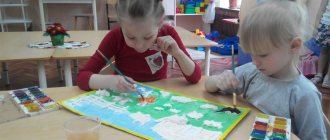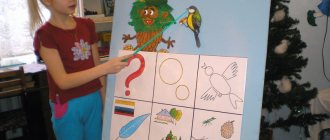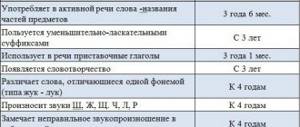Let's consider two types of analysis: self-analysis and peer analysis
The preparatory class in kindergarten is designed to prepare for school. The main goal is to raise a child and develop speech, the ability to express one’s thoughts, and communicate with peers.
Test lesson in kindergarten
Using the example analysis, the teacher can check himself for compliance with the requirements of the program, or undergo an official test.
During the test, the progress of the lesson is monitored and an assessment is made on all points:
- the goals and objectives of the lesson are revealed;
- the teacher explains the material clearly, interestingly and meaningfully;
- the children listened to the text with interest, understood its meaning and were able to retell it;
- Pupils learned to listen to each other’s answers and give hints, as well as answer independently.
During the lesson, the main goal should be achieved - the child’s retelling of a short text.
Scheme of analysis of a lesson on speech development in the middle group
The GCD lesson consists of three stages and is assessed using a template.
Lesson stages:
- Forming motivation for the lesson, inviting children to read a fairy tale.
- Fixing the purpose of the lesson orally in front of the children.
- Lesson and summary.
Speech development lesson
The teacher who conducts the analysis fills out a document template for verification and evaluates the work in the group. The template provides the following points for analysis:
- creation by the teacher of a suitable atmosphere for the lesson;
- children give monosyllabic or polysyllabic, detailed answers;
- the children openly dialogue and communicate with other children from the group;
- how well children perceive the information that the teacher conveys to them;
- whether the children’s speech apparatus is developing, whether they perform special exercises;
- is individual work carried out with lagging children?
- whether the structure of the lesson, change of activity and dynamic pause are observed;
- whether children's interest remains maintained throughout the lesson.
At the end of the document, the inspector puts his signature under the words “Analyzing the activities carried out in the group, I believe that the set goal and objectives were fully achieved.”
Schematic plan for analyzing a lesson on speech development in the senior group
For the test lesson, a special, coherent topic is chosen to develop reading and speaking skills.
Individual speech therapy support programs for children
Important! Children attending kindergarten are preparing for school in the senior group, therefore, the main task of the teacher is to provide assistance to those students who have difficulties in pronunciation and understanding the meaning of what they read, as well as general comprehensive work with all children to develop reading skills.
A schematic plan for lesson analysis looks like this:
Template for verification
During a lesson at a preschool educational institution, the teacher’s work is assessed, first of all, according to the following scheme:
- Ability to explain material accurately and logically.
- Perception of the child’s mental state: involvement, fatigue, anxiety, irritability;
- The presence of pedagogical tact, expressive speech;
- Ability to properly organize a lesson;
- Control of the educational process by the teacher.
Additional Information! Based on the results of the check, an overall score is assigned.
Template for analyzing a lesson in a preparatory group
To analyze a lesson in a preparatory group of a preschool educational institution, you need to use the following template:
Analysis of continuous educational activities in the senior group of the Municipal Budgetary Educational Institution “Name of the Garden”
- General information: age of children, full name of teacher, educational area “Speech Development”, topic and purpose of the lesson.
- Compliance of the lesson with the current standards of the Federal State Educational Standard, interaction between an adult and a child, compliance with the comprehensive thematic principle.
- Observing the progress of the lesson.
- Techniques and methods used.
- Analysis of the teacher's activities.
- Recommendations based on the results of the audit.
At the end of the document the name and signature of the inspector is placed.




